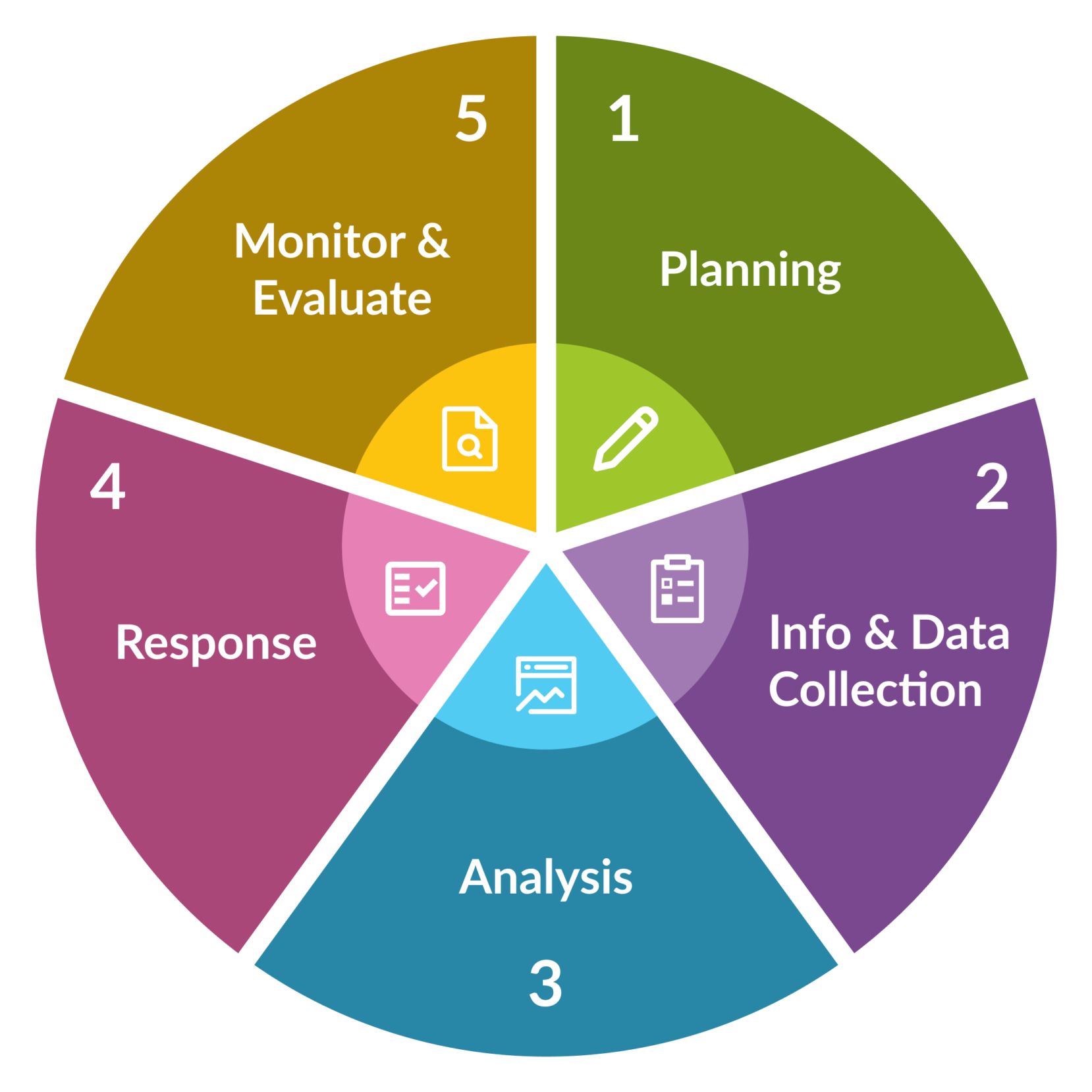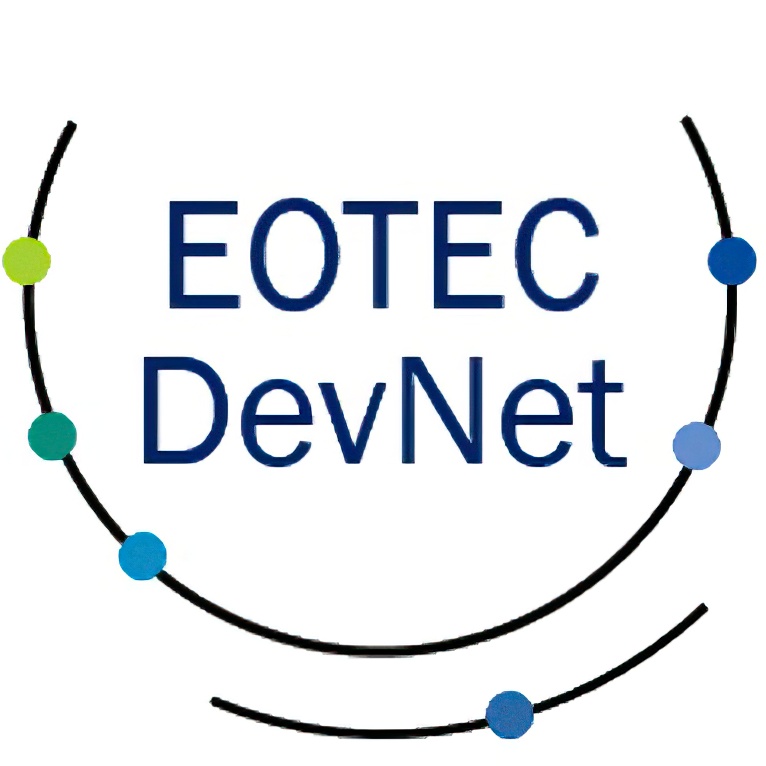Needs assessments often follow the 5-step approach represented in the graphic below. Click on the triangles to learn more about each step.

-
Planning
-
Info & Data Collection
-
Analysis
-
Response
-
Monitor & Evaluate
Effective needs assessment begins with careful planning. The first step is to identify and engage key stakeholders who will benefit from the capacity development intervention. Understanding who they are — including their characteristics, roles, needs, and prior experiences with capacity development — is critical to ensuring that the assessment is relevant and actionable.
Next, define the scope and focus of the needs assessment:
- Which skills, knowledge areas, or operational capacities are you aiming to assess?
- At what level will the assessment operate? For example, this could be at the individual, organizational, or system level.
Then, select appropriate assessment methods that best align with the stakeholder profiles and the overall goals of the needs assessment. These might center on surveys, focus groups, document reviews, or consultative workshops.
Throughout the planning process, it is essential to seek input from stakeholders to validate the approach, build support, and ensure that the assessment reflects the real-world needs and challenges of those you seek to assist.
Comprehensive planning lays the foundation for a strong needs assessment that will yield to targeted, meaningful, and sustainable capacity development outcomes.
Steps
- Identify and engage stakeholders
- Understand their characteristics, needs, and experience
- Determine assessment scope and focus
- Select assessment methods
- Seek stakeholder input on plans
The next critical phase of the needs assessment is gathering information and data to build a clear picture of current conditions and capacity gaps.
Start by mapping existing Earth observation (EO) use among the target audiences. Characterize how EO data and tools are currently applied, both broadly across sectors and specifically in relation to the intended impact of the capacity development effort. Understanding the real-world context in which stakeholders operate will help tailor future interventions more effectively.
Review past capacity development efforts and inventory existing assets, such as training programs, toolkits, partnerships, and institutional knowledge bases. Assess what resources are already available and where gaps exist. It is important to catalog these assets and also evaluate their relevance, accessibility, and effectiveness from the perspective of the target audiences.
Again, it is important to collaborate closely with stakeholders throughout the process to ensure that the assessment captures diverse experiences and priorities. Consistent engagement fosters ownership, builds trust, and uncovers insights and potential audiences that might not be visible through document review alone.
By systematically assessing the current status of EO use and capacity development activities, you will generate important evidence to support targeted, impactful interventions that respond directly to stakeholder needs.
Steps
- Map existing EO use
- Understand past capacity development efforts
- Inventory existing capacity development assets
- Identify gaps and needs
- Collaborate with stakeholders
The analysis phase is where the collected data is turned into actionable insights. The primary goal is to synthesize the information gathered during the assessment into clear, meaningful findings to guide decision-making.
Start by synthesizing the collected information into key insights. This involves analyzing trends, patterns, and discrepancies in the data, helping to identify the most critical needs, gaps, and opportunities for capacity development.
Next, report and visualize the findings in plain language that is accessible and understandable to stakeholders. Use clear, simple visuals, such as charts, graphs, and maps, to highlight the key results. Ensure that the presentation of data aligns with the audience’s needs. Also make sure the information is engaging and actionable.
Finally, share and validate the findings with stakeholders to ensure their accuracy and relevance. Present the findings in a collaborative setting, allowing stakeholders to provide feedback, refine interpretations, and validate conclusions. This step is indispensable – it ensures that the insights are well-grounded in the experiences of the target audience and sets the stage for collaborative implementation.
The analysis phase should result in a clear set of actionable recommendations for the next steps in the capacity development process, based on the evidence gathered.
Steps
- Synthesize collected information into key insights
- Report and visualize preliminary findings
- Share and validate findings with stakeholders
- Finalize findings
Once the analysis phase is complete, the next step is to design targeted capacity development interventions. These interventions should address the specific gaps and needs identified through the assessment, ensuring they are both relevant and impactful.
Before designing interventions, it is important to agree on definitions of impact and establish a preliminary monitoring and evaluation plan. This includes identifying key performance indicators (KPIs) or other measurements of impact that can be tracked during implementation.
Start by aligning the interventions with stakeholder goals. Ensure that the capacity development efforts are tailored to the priorities of the stakeholders, taking into account their current capabilities, challenges, and strategic objectives. This alignment will increase the likelihood of success and foster greater stakeholder buy-in.
Finally, implement the plans in collaboration with stakeholders. Engage stakeholders in the design, rollout, and evaluation of the interventions to ensure they are fully invested in the process. Continuous collaboration during implementation helps ensure that the interventions are adapted to changing circumstances and feedback, ensuring sustained impact.
By following this approach, capacity development efforts will be positioned to achieve their desired outcomes and contribute to the long-term capabilities of the stakeholders involved.
Steps
- Use findings to design targeted capacity development interventions
- Align interventions to stakeholder goals
- Implement plans with stakeholders
Ongoing monitoring and evaluation is essential for ensuring that the capacity development efforts are on track and achieving their intended outcomes. It involves continuously assessing the effectiveness of the interventions and making adjustments where necessary.
If necessary, adjust the response as needed based on the insights gathered during monitoring. Flexibility is crucial in ensuring that the interventions remain relevant and effective throughout the implementation process. This may include modifying strategies, re-prioritizing actions, or addressing unforeseen challenges.
Finally, it is important to document and share lessons learned throughout the process. Sharing insights, both positive and negative, contributes to continuous improvement and allows others to benefit from the experiences. Lessons learned can inform future capacity development efforts and help refine best practices.
Integrating monitoring and evaluation into the process ensures that capacity development interventions are both adaptive and impactful, delivering long-term value to stakeholders.
Steps
- Track the impact of capacity development efforts
- Adjust response as needed
- Document and share lessons learned
This information is drawn from capacity needs assessment tools including: the CEOS Webinar Needs Assessment Toolkit, Earth Observation Maturity Assessment, GEOGLAM Capacity Development Toolkit, NOAA Office of Coastal Management Needs Assessment Guide, UNDP’s Capacity Assessment Methodology User’s Guide, and SERVIR Service Planning Toolkit.
Visit the Tools page to explore these resources.





